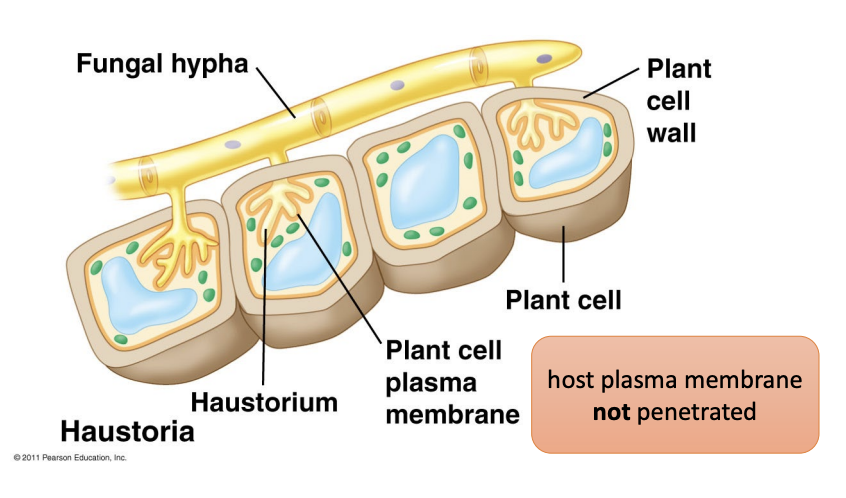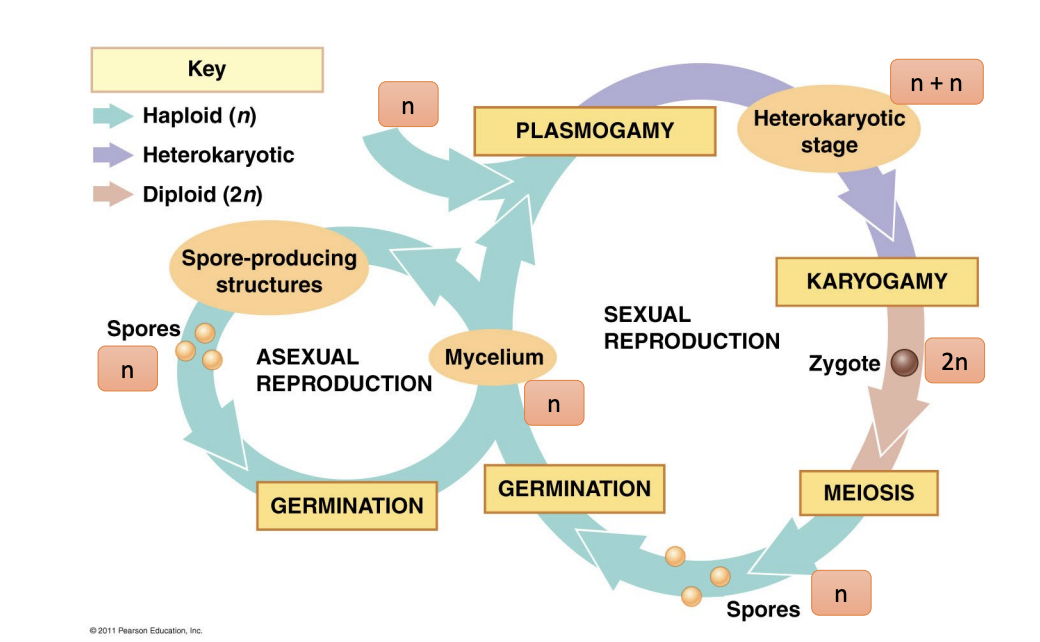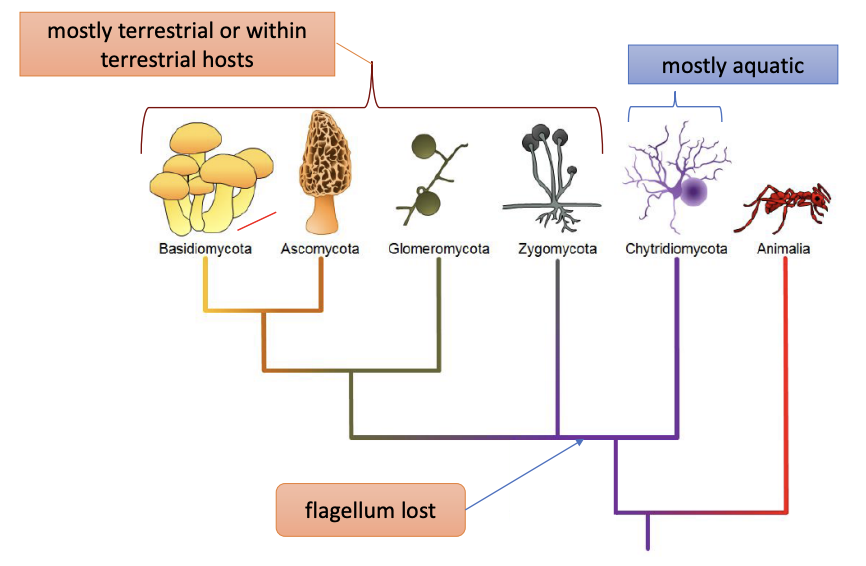FUNGI CHAPTER 24
1/44
There's no tags or description
Looks like no tags are added yet.
Name | Mastery | Learn | Test | Matching | Spaced |
|---|
No study sessions yet.
45 Terms
describe the nucleus structure of a fungal cell
As eukaryotes, fungal cells contain a membrane-bound nucleus
The DNA in the nucleus is wrapped around histone proteins
A few types of fungi have accessory genomic structures comparable to bacterial plasmids (loops of DNA)
True or False: Horizontal transfer of genetic information that occurs between one bacterium and another also often occurs in fungi
FALSE
Hh\ow does the structure of fungal cells differ from plant cells?
Unlike plant cells, fungal cells do not have chloroplasts or chlorophyll
What organelles do fungal cells contain?
Fungal cells also contain mitochondria and a complex system of internal membranes, including the endoplasmic reticulum and Golgi apparatus
What function to the pigments in fungi have?
Pigments in fungi are associated with the cell wall and play a protective role against ultraviolet radiation
Some fungal pigments are toxic to humans
Describe the structure of fungal cell walls
The rigid layers of fungal cell walls contain complex polysaccharides called chitin and glucans
Chitin (N-acetyl-D-glucosamine), gives structural strength to the cell walls of fungi
What is ergosterol?
Fungal plasma membranes are stabilized by ergosterol: a steroid molecule that replaces the cholesterol found in animal cell membranes
Give examples of fungi
bread mold
mushrooms
shelf fungus
puffballs
cup fungi
What environment do Chytrids live in?
Aquatic
Where do unicellular yeast fungi live? Give 2 examples of unicellular yeast fungi.
Live on water films and moist tissue
EX: Brewer’s yeast and vaginal yeast
What is mycelium?
The main fungus body is a mycelium
a network of filamentous (thread-like) hyphae (singular-hypha) often unseen: underground or within hosts
feeds & grows; often enormous
What are Hyphae? What is it made of? What does the cell membrane contain?
Hyphae are made of tubular cells with rigid cell walls containing chitin
Chitin is a polymer of N-acetylglucosamine
Cell membranes contain ergosterol, not cholesterol
What is the difference and similarity between septate hyphae and coenocytic hyphae?
septate (cross walls) or coenocytic (“common cytoplasm”) hyphae
both allow rapid cytoplasmic streaming

How do hyphae feed? what do they secrete and why?
Hyphae feed by absorbing simple organic compounds
thus fungi are absorptive heterotrophs
most secrete hydrolytic enzymes & acids
this digests organic materials
Fungi are mostly saprobes
Some fungi are parasitic, infecting either plants or animals
What are haustoria? What do they do?
some specialized hyphae:
haustoria penetrate cell walls of host plant without killing cell

What is the relation between nematodes and hyphae?
some hyphae “catch” nematodes for Nitrogen!
During fungal reproduction, where do the reproductive bodies emerge from?
a mycelium to make spores
In what cycles are spores made and describe the process of fungal reproduction
Spores are made in both sexual and asexual cycles
one cell (haploid, n), protected by coating
disperse by air/ water to new resources
spores germinate on food source
each grows into a new haploid (n) mycelium
How does the process of asexual reproduction with spores by mitosis work?
grow new genetically identical mycelia
What are the two types of asexual spores?
conidiospores, sporangiospores
What is a sporangium?
Spores may be released from the parent thallus either outside or within a special reproductive sac called a sporangium
What are the three different types of asexual fungal reproduction and describe them
budding: a bulge forms on the side of the cell, the nucleus divides mitotically, and the bud ultimately detaches itself from the mother cell
Somatic cells in yeast form buds
fragmentation: bits of mycelium can grow into new individual
asexual spores: by mitosis, grow new genetically identical mycelia
When is sexual fungal reproduction called homothallic? When is it heterothallic?
when both mating types are present in the same mycelium, it is called homothallic, or self-fertile
Heterothallic mycelia require two different, but compatible, mycelia to reproduce sexually
For sexual fungal reproduction there are no genders so what are the two mating types?
(+) or (–)
What are the three steps to form a zygote in sexual fungal reproduction?
plasmogamy = fusion of haploid (+) & (–) hyphae
heterokaryotic stage = hyphae with unfused haploid nuclei of both types
karyogamy = fusion of +/– haploid nuclei to form zygote (2n)
How does sexual fungal reproduction make diverse spores?
zygote (2n) always does meiosis, making genetically diverse spores (n)
(never a multicellular 2n stage)
Describe the generalized fungal life cycle

describe the fungus phylogeny, which ones are mostly terrestrial and which are mostly aquatic? At what point is the flagellum lost?

Chytrids: Describe them, their structure, how they are different from other fungi, and their role in the environment
the simplest and most primitive Eumycota, or true fungi
have chitin in their cell walls
most chytrids are unicellular
a few form multicellular organisms and coenocytic hyphae
Chytrids are the only fungi that have retained flagella
flagellated spores (zoospores) and gametes
aquatic decomposers (saprobes) or parasites
Zygomycetes: describe them, their role, how they reproduce, and an example
sexual cycle makes a resistant zygosporangium
coenocytic hyphae
most species are saprobes (an organism that breaks down dead or decaying organic matter for nutrients)
a few are parasites, particularly of insects
Usually reproduce asexually by producing sporangiospores
EX: Rhizopus sp. bread mold
Ascomycota: The Sac Fungi, what are the two different types and give 3 examples
sexual spores (ascospores) within saclike ascus (plural asci)
asexual spores (conidiospores) are released by conidiophores
EX: cup fungus, morel, Tuber melanosporum (truffle)
Basidiomycota: The Club Fungi, what type of spores do they have, what is its reproductive organ called, give an example
sexual spores (basidiospores) within club-like basidium
basidia, which are the reproductive organs of these fungi, are often contained within the familiar mushroom
EX: common mushroom
Glomeromycota: what type of relationship do they have
mutualistic arbuscular mycorrhizae
90% of plant species have a mycorrhizal relationship
Describe the growth and surface area of fungi
rapid growth at hyphal tips toward new food (no motile feeding cells)
huge total surface area for absorption
What is the importance of fungi?
Fungi are Decomposers
Fungi Damage Property
Fungi are Mutualists
Fungi are Pathogens
Fungi Benefit Medicine & Research
Fungi & Food
Poisonous Fungi
How do fungi differ from bacteria as decomposers?
Many bacteria & fungi are great at decomposing cellulose, but most bacteria cannot break down lignin (fungi can!)
How do fungi damage property?
“Dry rot” & “wet rot” & “mold” & “mildew”
How are fungi mutualists?
mycorrhizal fungi help plants absorb moisture & minerals
fungus “gets” sugars, etc., from plant
What are the three types of mutualistic fungi and describe them
Ectomycorrhizae
Fungus remains outside root and between cells
Endomycorrhizae (arbuscular mycorrhizae)
fungi penetrate cell walls and form haustoria
All Glomeromycetes are endomycorrhiza
Lichens
fungi living in close association w/ photosynthetic unicellular chlorophyte or cyanobacteria
fungus “gives” framework, moisture, minerals
algae/cyanobacteria “gives” sugar • can reproduce as “dual organism” via soredia
How are fungi pathogens to plants? what do they produce?
Infecting plants:
attack trees, landscape plants, crops
e.g., rusts & smuts
Several produce mycotoxins e.g., ergot – ergotism, LSD
Claviceps purpurea causes ergot on rye, barley and other grasses
Probable cause of St. Anthony’s fire
What type or neurological symptoms does fungus cause and how?
Fungus produces alkaloid toxins that cause severe physiological & neurological symptoms
Hallucinations
Burning skin sensation
Bug crawling feeling
Gangrene due to vasoconstriction
Tremors
Still births
Abortion
How do fungi infect humans? what type of infections can it cause? which ones are treatable and which ones are severe?
Infecting humans
mycosis = infection due to fungus
some very serious, difficult to treat
Ex: “valley fever” (coccidioidomycosis)
many common, treatable
Ex: ringworm, oral thrush, athlete’s foot, jock itch, vaginal yeast infections
How are fungi important in medicine and research? Give an example of a fungi used
Source of antibiotics & other meds
Ex: penicillin, cephalosporins
Genetic research & biotechnology
Ex: Neurospora research model organism
Dr. Bell-Pederson
Dr. Sachs
Ex: yeasts
How do we use fungi in our food? Give examples of foods.
Yeasts do fermentation
ethyl alcohol in beer, wine, etc.
CO2 for rising bread
Molds used in food processing
Ex: bleu cheese, soy sauce
Give examples of poisonous fungi
Moldy foods can kill humans, livestock!
Ex: ergotism from ergot on rye
Ex: aflatoxin from Aspergillus on corn, peanuts, etc
Many mushrooms are deadly!
Never eat wild fungi!